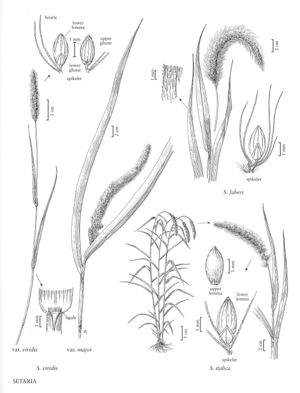Difference between revisions of "Setaria faberi"
FNA>Volume Importer |
imported>Volume Importer |
||
| (2 intermediate revisions by the same user not shown) | |||
| Line 4: | Line 4: | ||
|publications= | |publications= | ||
|common_names=Chinese foxtail;Setaire géante | |common_names=Chinese foxtail;Setaire géante | ||
| + | |special_status={{Treatment/ID/Special_status | ||
| + | |code=I | ||
| + | |label=Introduced | ||
| + | }} | ||
|basionyms= | |basionyms= | ||
|synonyms= | |synonyms= | ||
| Line 16: | Line 20: | ||
-->{{Treatment/Body | -->{{Treatment/Body | ||
| − | |distribution=Conn.;N.J.;N.Y.;W.Va.;Del.;D.C;Wis.;Ont.;Que.;Fla.;La.;Tenn.;N.C.;S.C.;Pa.;N.H.;R.I.;Kans.;Nebr.;Okla.;S.Dak.;Va.;Md.;Mass.;Vt.;Calif.;Ala.;Ark.;Ill.;Ga.;Ind.;Iowa;Ariz.;Maine;Ohio;Mo.;Minn.;Mich.;Miss.;Ky. | + | |distribution=Conn.;N.J.;N.Y.;W.Va.;Del.;D.C.;Wis.;Ont.;Que.;Fla.;La.;Tenn.;N.C.;S.C.;Pa.;N.H.;R.I.;Kans.;Nebr.;Okla.;S.Dak.;Va.;Md.;Mass.;Vt.;Calif.;Ala.;Ark.;Ill.;Ga.;Ind.;Iowa;Ariz.;Maine;Ohio;Mo.;Minn.;Mich.;Miss.;Ky. |
|discussion=<p><i>Setaria faberi</i> spread rapidly throughout the North American corn belt after being accidentally introduced from China in the 1920s. It has become a major nuisance in corn and bean fields of the midwestern United States.</p> | |discussion=<p><i>Setaria faberi</i> spread rapidly throughout the North American corn belt after being accidentally introduced from China in the 1920s. It has become a major nuisance in corn and bean fields of the midwestern United States.</p> | ||
|tables= | |tables= | ||
| Line 34: | Line 38: | ||
|illustrator=Linda A. Vorobik;Annaliese Miller | |illustrator=Linda A. Vorobik;Annaliese Miller | ||
|illustration copyright=Utah State University | |illustration copyright=Utah State University | ||
| − | |distribution=Conn.;N.J.;N.Y.;W.Va.;Del.;D.C;Wis.;Ont.;Que.;Fla.;La.;Tenn.;N.C.;S.C.;Pa.;N.H.;R.I.;Kans.;Nebr.;Okla.;S.Dak.;Va.;Md.;Mass.;Vt.;Calif.;Ala.;Ark.;Ill.;Ga.;Ind.;Iowa;Ariz.;Maine;Ohio;Mo.;Minn.;Mich.;Miss.;Ky. | + | |distribution=Conn.;N.J.;N.Y.;W.Va.;Del.;D.C.;Wis.;Ont.;Que.;Fla.;La.;Tenn.;N.C.;S.C.;Pa.;N.H.;R.I.;Kans.;Nebr.;Okla.;S.Dak.;Va.;Md.;Mass.;Vt.;Calif.;Ala.;Ark.;Ill.;Ga.;Ind.;Iowa;Ariz.;Maine;Ohio;Mo.;Minn.;Mich.;Miss.;Ky. |
|reference=None | |reference=None | ||
|publication title= | |publication title= | ||
|publication year= | |publication year= | ||
| − | |special status= | + | |special status=Introduced |
| − | |source xml=https:// | + | |source xml=https://bitbucket.org/aafc-mbb/fna-data-curation/src/200273ad09963decb8fc72550212de541d86569d/coarse_grained_fna_xml/V25/V25_1422.xml |
|subfamily=Poaceae subfam. Panicoideae | |subfamily=Poaceae subfam. Panicoideae | ||
|tribe=Poaceae tribe Paniceae | |tribe=Poaceae tribe Paniceae | ||
Latest revision as of 17:57, 11 May 2021
Plants annual. Culms 50-200 cm. Sheaths glabrous, fringed with white hairs; ligules about 2 mm; blades 15-30 cm long, 10-20 mm wide, usually with soft hairs on the adaxial surface. Panicles 6-20 cm, densely spicate, arching and drooping from near the base; rachises densely villous; bristles (1)3(6), about 10 mm. Spikelets 2.5-3 mm. Lower glumes about 1 mm, acute, 3-veined; upper glumes about 2.2 mm, obtuse, 5-veined; lower lemmas about 2.8 mm, obtuse; lower paleas about 2/3 as long as the lower lemmas; upper lemmas pale, finely and distinctly transversely rugose; upper paleas similar to the upper lemmas. 2n = 36.
Distribution
Conn., N.J., N.Y., W.Va., Del., D.C., Wis., Ont., Que., Fla., La., Tenn., N.C., S.C., Pa., N.H., R.I., Kans., Nebr., Okla., S.Dak., Va., Md., Mass., Vt., Calif., Ala., Ark., Ill., Ga., Ind., Iowa, Ariz., Maine, Ohio, Mo., Minn., Mich., Miss., Ky.
Discussion
Setaria faberi spread rapidly throughout the North American corn belt after being accidentally introduced from China in the 1920s. It has become a major nuisance in corn and bean fields of the midwestern United States.
Selected References
None.
